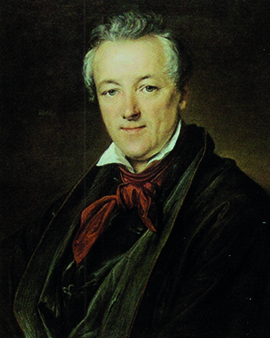


Pyotr Fyodorovich Sokolov, as he is spelled in German, was born in Moscow in 1791 and must have been considered a child prodigy at a very early age - he was accepted at the Imperial Academy of Arts in St. Petersburg as early as 1800, when he was nine years old!
Sokolov remained at the academy for nine years. While cannonballs flew around the rest of Europe, half a dozen states took up arms against Napoleon in ever-changing coalitions and were repeatedly defeated, Sokolov delivered his journeyman's piece in 1809 with "Andromache mourns Hector", which earned him the Small Gold Medal of the Academy. However, he did not achieve his great goal, the Grand Gold Medal and, connected with it, a scholarship for studies abroad (Sokolov wanted to go to Italy), even at his second attempt.
So Sokolov stayed in the country and nourished himself honestly: after the final victory over Napoleon, especially through the "Patriotic War" of 1812, the empire of the young Tsar Alexander saw itself as a blossoming empire, whose state-bearing classes were bursting with self-confidence. With his portraits, Sokolov served their need for recognition - he managed to capture on canvas almost the entire social and political prominence of the empire. Even Tsar Nicholas I had him come to the court in 1821 to paint portraits of the then three-year-old heir to the throne, subsequently Tsar Alexander II - Sokolov's clients also included: Alexander Pushkin, enfant terrible of his time and today the national poet of Russia, as well as his mentor and tutor to the heir to the throne, Vasily Zhukovsky. Also Elena Pavlovna Bakunina, the daughter of the governor of the capital and cousin of the revolutionary Mikhail Bakunin, who had herself portrayed three times in different phases of her life - and who made a name for herself as "Russia's first nurse" long after Sokolov's death in 1848, during the Crimean War. She was not the only client who had herself portrayed by Sokolov several times,
This illustrious influx for a single artist is ultimately explained by his painting style: For Sokolov was the pioneer of watercolor painting in Russia; he had already discovered the rather light watercolors with and without emulsion for himself at the Academy, which gave his portraits a light, buoyant note; some of his paintings seem almost as if they were softly breathed in comparison to the "thick oil hams" of the Classical School.
When Pyotr Sokolov died in 1848, he left not only an oeuvre of 500 paintings, but also three sons (Pyotr, Pavel and Alexander), who in turn were to achieve fame as painters and/or illustrators.

Pyotr Fyodorovich Sokolov, as he is spelled in German, was born in Moscow in 1791 and must have been considered a child prodigy at a very early age - he was accepted at the Imperial Academy of Arts in St. Petersburg as early as 1800, when he was nine years old!
Sokolov remained at the academy for nine years. While cannonballs flew around the rest of Europe, half a dozen states took up arms against Napoleon in ever-changing coalitions and were repeatedly defeated, Sokolov delivered his journeyman's piece in 1809 with "Andromache mourns Hector", which earned him the Small Gold Medal of the Academy. However, he did not achieve his great goal, the Grand Gold Medal and, connected with it, a scholarship for studies abroad (Sokolov wanted to go to Italy), even at his second attempt.
So Sokolov stayed in the country and nourished himself honestly: after the final victory over Napoleon, especially through the "Patriotic War" of 1812, the empire of the young Tsar Alexander saw itself as a blossoming empire, whose state-bearing classes were bursting with self-confidence. With his portraits, Sokolov served their need for recognition - he managed to capture on canvas almost the entire social and political prominence of the empire. Even Tsar Nicholas I had him come to the court in 1821 to paint portraits of the then three-year-old heir to the throne, subsequently Tsar Alexander II - Sokolov's clients also included: Alexander Pushkin, enfant terrible of his time and today the national poet of Russia, as well as his mentor and tutor to the heir to the throne, Vasily Zhukovsky. Also Elena Pavlovna Bakunina, the daughter of the governor of the capital and cousin of the revolutionary Mikhail Bakunin, who had herself portrayed three times in different phases of her life - and who made a name for herself as "Russia's first nurse" long after Sokolov's death in 1848, during the Crimean War. She was not the only client who had herself portrayed by Sokolov several times,
This illustrious influx for a single artist is ultimately explained by his painting style: For Sokolov was the pioneer of watercolor painting in Russia; he had already discovered the rather light watercolors with and without emulsion for himself at the Academy, which gave his portraits a light, buoyant note; some of his paintings seem almost as if they were softly breathed in comparison to the "thick oil hams" of the Classical School.
When Pyotr Sokolov died in 1848, he left not only an oeuvre of 500 paintings, but also three sons (Pyotr, Pavel and Alexander), who in turn were to achieve fame as painters and/or illustrators.
Page 1 / 1






